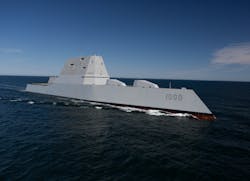Scientists at the U.S. Naval Research Laboratory (NRL; Washington, DC) have developed a method to fabricate spinel, which is a transparent ceramic used in the IR as transparent optically functional armor, in a nanocrystalline form that is 50% harder than the current spinel armor materials used in military vehicles.1
Spinel is one of the transparent ceramics—along with ALON (aluminum oxy nitride with a cubic spinel crystal structure)—that is tough, strong, and usable as optical material in the IR. The NRL researchers took advantage of the inverse Hall-Patch relationship, in which a ceramic material's strength grows when the grain size is reduced below 100 nm. Sapphire, which is monocrystalline, is also used for these windows.
The researchers showed that spinel followed the inverse Hall-Patch relationship down to 28 nm grain sizes, resulting in a 50% increase in hardness to 20.2 GPa for spinel without a decrease in fracture resistance.
Fully dense
To create the harder spinel, the NRL research team sintered commercial nanopowders into fully dense nanocrystalline materials. The NRL team is the first to succeed in making this harder spinel through their development of a so-called enhanced high-pressure sintering (EHPS) approach, explains James Wollmershauser, one of the lead researchers. The EHPS approach uses high pressures (up to 6 GPa) to retard bulk diffusion rates, break powder agglomerates, and reposition nanoparticles very close to each other to help eliminate porosity in the sintered ceramic. NRL researchers then can exploit the increased surface potential of nanoparticles for surface-energy-driven densification without coarsening.
Reduced density in previous researchers' work was caused by voids that cannot be removed during processing, which can reduce hardness, fracture resistance and transparency. In their work, the NRL researchers showed that the spinel's fracture resistance does not change, suggesting that nanocrystalline ceramics can have an equivalent toughness to microcrystalline ceramics.
By increasing the hardness of spinel as they did in their research, NRL researchers can make a material harder than sapphire, possibly replacing sapphire windows with windows made out of nanocrystalline spinel.
Someday smartphones?
Someday, the harder spinel could even be used for stronger smartphone screens.
REFERENCE:
1. James A. Wollmershauser et al, Acta Materialia (2014); http://dx.doi.org/10.1016/j.actamat.2014.01.030

John Wallace | Senior Technical Editor (1998-2022)
John Wallace was with Laser Focus World for nearly 25 years, retiring in late June 2022. He obtained a bachelor's degree in mechanical engineering and physics at Rutgers University and a master's in optical engineering at the University of Rochester. Before becoming an editor, John worked as an engineer at RCA, Exxon, Eastman Kodak, and GCA Corporation.
